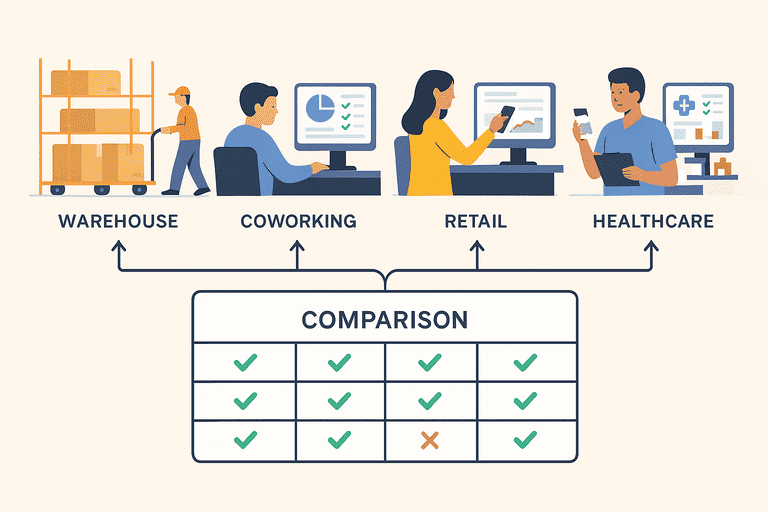Top 10 Inventory Management Tools Compared (2025 Edition)
Explore and compare the top 10 inventory management tools in 2025. Features, pricing, and pros/cons to help you pick the right solution.

Introduction
Choosing the right inventory management tool can feel overwhelming. Dozens of platforms promise to simplify tracking, cut losses, and improve accountability.
But not every tool fits every business. Some are built for eCommerce, others for manufacturing, and some — like InvyMate — are designed for shared economy and hybrid teams.
This article provides a neutral comparison of the top 10 inventory management tools in 2025, highlighting their features, pricing, and best-fit use cases.
1. NetSuite ERP
Best for: Large enterprises needing a full ERP solution.
- Features: End-to-end ERP with advanced inventory, finance, and supply chain modules.
- Pros: Highly customizable, great for global companies.
- Cons: Expensive and complex for SMBs.
2. Zoho Inventory
Best for: Small businesses and startups.
- Features: Stock tracking, order management, shipping integrations.
- Pros: Affordable, integrates with Zoho ecosystem.
- Cons: Limited advanced reporting.
3. TradeGecko (QuickBooks Commerce)
Best for: eCommerce and wholesalers.
- Features: Inventory + order management with QuickBooks integration.
- Pros: Seamless finance + inventory workflows.
- Cons: Less suited for asset-heavy industries.
4. Sortly
Best for: SMBs that want simplicity.
- Features: QR/Barcode scanning, visual catalogs, mobile app.
- Pros: Very user-friendly, fast adoption.
- Cons: Limited advanced automation.
5. Asset Panda
Best for: Asset-heavy industries (IT, healthcare, construction).
- Features: Asset tracking, depreciation, custom workflows.
- Pros: Highly configurable.
- Cons: UI can feel clunky.
6. InvyMate
Best for: Shared economy businesses, coworking spaces, hybrid teams, cafes, and SMBs.
- Features:
- QR-code powered.
- Cloud-based dashboard.
- Mobile-first scanning.
- Pros: Tailored for collaborative environments; affordable.
- Cons: Not yet as feature-heavy as enterprise ERP suites.
7. Odoo Inventory
Best for: Businesses already using Odoo ERP.
- Features: Open-source ERP modules including inventory.
- Pros: Modular and customizable.
- Cons: Requires technical setup.
8. Fishbowl Inventory
Best for: Manufacturing and warehouse operations.
- Features: Inventory + production tracking, QuickBooks integration.
- Pros: Popular in manufacturing, deep functionality.
- Cons: Steeper learning curve.
9. Cin7
Best for: Multi-channel retailers.
- Features: POS, inventory, and eCommerce integrations.
- Pros: Strong integrations for Shopify, Amazon, etc.
- Cons: Can be complex to configure.
10. Katana MRP
Best for: Small manufacturers.
- Features: Inventory + production planning.
- Pros: Intuitive for SMB manufacturers.
- Cons: Limited outside manufacturing context.
Key Takeaways from the Comparison
- For Enterprises: NetSuite, Fishbowl, or Odoo ERP.
- For eCommerce/Retail: Cin7, TradeGecko, Zoho Inventory.
- For Asset-Heavy Industries: Asset Panda, Katana.
- For Shared Economy & SMBs: Sortly or InvyMate (tailored for collaborative teams).
👉 Related: The Future of QR Code Inventory Tracking in 2025 and Beyond
Conclusion
The “best” inventory management tool depends on your industry, team size, and goals.
- Large enterprises may need full ERP suites.
- eCommerce companies benefit from order-focused solutions.
- Asset-heavy teams require depreciation and lifecycle tracking.
- Shared economy businesses thrive on lightweight, collaborative tools like InvyMate.
The right choice saves time, reduces costs, and keeps your operations running smoothly.
👉 Looking for an inventory system designed for coworking spaces, SMBs, and shared teams? Try InvyMate — simple, QR-powered, and built for collaboration.